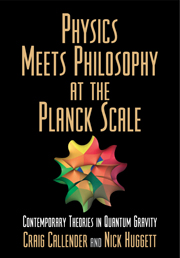Book contents
- Frontmatter
- Contents
- Preface
- 1 Introduction
- Part I Theories of Quantum Gravity and their Philosophical Dimensions
- Part II Strings
- Part III Topological Quantum Field Theory
- Part IV Quantum Gravity and the Interpretation of General Relativity
- Part V Quantum Gravity and the Interpretation of Quantum Mechanics
- 12 Quantum spacetime without observers: Ontological clarity and the conceptual foundations of quantum gravity
- 13 On gravity's role in quantum state reduction
- 14 Why the quantum must yield to gravity
- References
- Notes on contributors
- Index
14 - Why the quantum must yield to gravity
Published online by Cambridge University Press: 15 December 2009
- Frontmatter
- Contents
- Preface
- 1 Introduction
- Part I Theories of Quantum Gravity and their Philosophical Dimensions
- Part II Strings
- Part III Topological Quantum Field Theory
- Part IV Quantum Gravity and the Interpretation of General Relativity
- Part V Quantum Gravity and the Interpretation of Quantum Mechanics
- 12 Quantum spacetime without observers: Ontological clarity and the conceptual foundations of quantum gravity
- 13 On gravity's role in quantum state reduction
- 14 Why the quantum must yield to gravity
- References
- Notes on contributors
- Index
Summary
Introduction: From Schrödinger's cat to Penrose's ‘OR’
Quantum mechanics – one of our two most fundamental and successful theories – is infested with a range of deep philosophical difficulties collectively known as the measurement problem (Shimony 1963, Bell 1990). In a nutshell, the problem may be stated as follows: If the orthodox formulation of quantum theory – which in general allows attributions of only objectively indefinite properties or potentialities (Heisenberg 1958) to physical objects – is interpreted in compliance with what is usually referred to as scientific realism, then one is faced with an irreconcilable incompatibility between the linearity of quantum dynamics – which governs evolution of the network of potentialities – and the apparent definite or actual properties of the physical objects of our ‘macroscopic’ world. Moreover, to date no epistemic explanation of these potentialities (e.g. in terms of ‘hidden variables’) has been completely successful (Shimony 1989). Thus, on the one hand there is overwhelming experimental evidence in favour of the quantum mechanical potentialities, supporting the view that they comprise a novel (i.e. classically uncharted) metaphysical modality of Nature situated between logical possibility and actuality (Shimony 1978, 1993a, pp. 140–62 and pp. 310–22), and on the other hand there is phenomenologically compelling proliferation of actualities in our everyday world, including even in the microbiological domain. The problem then is that a universally agreeable mechanism for transition between these two ontologically very different modalities – i.e. transition from the multiplicity of potentialities to various specific actualities – is completely missing.
- Type
- Chapter
- Information
- Physics Meets Philosophy at the Planck ScaleContemporary Theories in Quantum Gravity, pp. 305 - 338Publisher: Cambridge University PressPrint publication year: 2001
- 4
- Cited by



